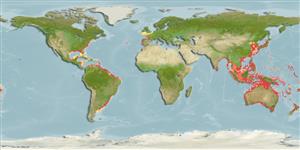Scyphozoa |
Semaeostomeae |
Pelagiidae
Environment: milieu / climate zone / गहराई सीमा / distribution range
पारिस्थितिकी
पिलाजिक; गहराई सीमा 0 - 85 m (संदर्भ 116114). Temperate
Pacific, Atlantic and Indian Oceans.
Length at first maturity / आकार / Weight / Age
परिपक्व अवधि: Lm ? range ? - ? cm Max length : 25.0 cm WD पुल्लिंग / अलिंग; (संदर्भ 2992)
Neritic, estuarine (Ref. 116114). Euryhaline medusae occurring in mixohaline and euhaline waters (3 to 5 parts per thousand). Feeds on polychaetes and comb jellies. Preyed upon by spider crabs, harvest fish and orange filefish. Acts as shelter for young harvest fish (Peprilus elepidotus). Venomous. Associated with Libinia dubia (Ref. 3095).
Undergoes metagenesis, alternation between polyp and medusa generation. Sessile polyps reproduce asexually (i.e. podocyst formation). During spring and summer, undergoes strobilation to give rise to ephyrae, which rapidly grows into dioecious medusae. Hermaphroditism is known but rare. Eggs are shed into gastrovascular cavity. Fertilization takes place either in the cavity or externally and produces free-swimming planula larvae, which settles on firm substrate and eventually develop in polyps.
Calder, D.R. 1972 Tentative outline for inventory of planktonic Cnidaria: Chrysaora quinquecirrha (stinging nettle). Chesapeake Science 13 (Suppl.: Biota of the Chesapeake Bay): S179-S181. (संदर्भ 3065)
IUCN Red List Status
(संदर्भ 130435: Version 2025-1)
CITES status (संदर्भ 108899)
Not Evaluated
CMS (संदर्भ 116361)
Not Evaluated
Threat to humans
Human uses
| FishSource |
साधन
अधिक जानकारी
Population dynamicsबाढ़Max. ages / sizesLength-weight rel.Length-length rel.Length-frequenciesMass conversionबहुतायत PhysiologyOxygen consumption
Human RelatedStamps, coins, misc.
इंटरनेट स्रोत
Estimates based on models
Fishing Vulnerability
Low vulnerability (13 of 100).
Price category
Unknown.
